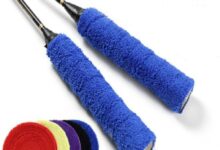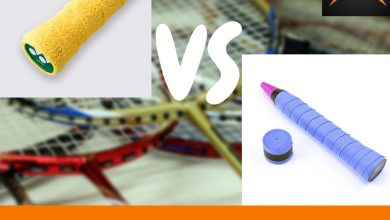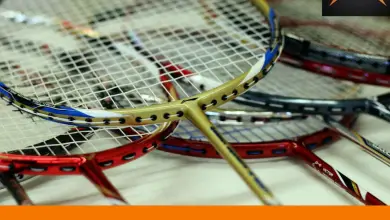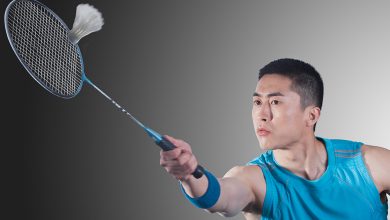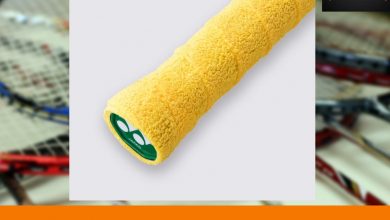Badminton Towel Grip vs Rubber : Which One To Choose and Why
In the world of badminton, having the right grip tape on your racket can make a significant difference in your performance on the court. Grip tapes, also known as racket grips or graps, come in a variety of materials and styles, each catering to the specific needs and preferences of the player. The primary purpose of grip tapes is to provide comfort, control, and stability while holding the racket, which in turn affects a player’s overall performance.
There are two main categories of grip tapes in badminton: towel grips and rubber (synthetic) grips. Towel grips, as the name suggests, are made from soft fabric materials that effectively absorb sweat, making them ideal for players with sweaty palms. On the other hand, rubber or synthetic grips are made from materials like polyurethane and offer a tacky feel which enhances control over the racket. These grips are preferred by players who prioritize grip and control over sweat absorption.
In addition to material differences, grip tapes also come in various thicknesses and textures, ranging from ribbed to meshed styles. Players need to experiment with different grips to find the perfect balance between comfort, control, and sweat absorption. Ultimately, the choice of grip tape boils down to personal preference, as one player’s perfect grip may not necessarily suit another. Stay informed about the options available on the market and don’t be afraid to test them out until you find your ideal grip tape for success on the badminton court.
Rubber Grip Tape vs. Towel Grip Tape
When it comes to choosing the right grip tape for your badminton racket, the two most popular options are rubber grip tape and towel grip tape. Both have their own set of advantages and disadvantages, ultimately coming down to personal preferences and playing conditions.
Rubber grip tape, made from synthetic materials, is known for its durability and ability to stay in place during gameplay. It is often more affordable than towel grip tape and offers a smoother surface, which some players find easier to adjust and control during a match. However, rubber grip tape may not be the best choice for players with sweaty hands, as it tends to be less absorbent than towel grip tape.
On the other hand, towel grip tape, made from dense cotton, is highly absorbent and provides a fuzzy texture that works well for players with sweaty hands or those playing in humid conditions. Towel grip tapes offer a comfortable hold and can be adjusted according to the player’s hand thickness preferences. However, these grips can be more expensive, require frequent replacements, and may feel heavier due to their thick composition.
In conclusion, choosing between rubber grip tape and towel grip tape depends on your personal preferences, playing conditions, and other factors like cost and durability. Assessing the benefits of each type of grip and weighing them against your needs can help you make an informed decision for the most comfortable and effective badminton experience.

Advantages of Rubber Grip Tape
Rubber grip tape is a popular alternative to towel grip for badminton players. Made from high-quality rubber materials, this grip option offers several advantages that contribute to a comfortable and effective playing experience.
Firstly, rubber grip tapes provide excellent grip and support, allowing players to hold onto their racquets with ease. This enhanced grip enables better control over shots and helps prevent the racquet from slipping out of the hand during intense gameplay.
Secondly, rubber grip tapes are highly durable and long-lasting compared to towel grips. They are designed to withstand wear and tear from frequent use, reducing the need for frequent replacements. This can be cost-effective for players who participate in badminton games regularly.
Thirdly, rubber grip tapes are generally easier to apply and maintain than towel grips. Application usually involves simply wrapping the tape around the racquet handle, without the need for any additional equipment such as adhesive sprays or rubber gloves. In terms of maintenance, rubber grip tapes can be wiped clean and tend to get less dirty and worn down, ensuring a consistently high level of performance.
Lastly, rubber grip tapes are available in a wide variety of colors and designs, allowing players to personalize their racquet handles according to their preferences. This not only adds a touch of individuality to the player’s equipment but also boosts the overall aesthetics of the racquet.
Advantages of Towel Grip Tape
Badminton players often face a dilemma when selecting the ideal grip tape for their racquets, and while towel grip tape might not be suitable for everyone, it presents several advantages that make it worth considering. One of the main benefits of using towel grip tape is its superior sweat absorption properties. As it consists of dense cotton fibers, the towel grip tape can effectively absorb moisture, ensuring a firm and non-slippery grip throughout the match or practice session. This makes it particularly suitable for players with sweaty hands or those playing in humid conditions.
Another advantage of towel grip tape is its customizable nature. Players can easily adjust the thickness of the grip according to their preferences by simply adding or removing layers of the tape. This allows athletes to achieve optimal comfort and control over their racquets. Moreover, the fuzzy texture of this tape offers added comfort, making it an excellent choice for players who seek a pleasant-feeling grip.
Lastly, towel grip tape’s durability makes it a cost-effective option in the long run. Although it might require more frequent replacement than synthetic or overgrips, the investment in superior sweat absorption and customized comfort may outweigh the cost of more frequent tape changes for some players. Overall, the advantages of towel grip tape make it a worthwhile option for badminton enthusiasts searching for the perfect fit for their racquet grip.
Disadvantages of Rubber Grip Tape
One of the essential aspects of any badminton player’s gear is the grip on their racket. While rubber grip tapes are commonly used, it is crucial to consider some of the disadvantages that may impact performance and overall satisfaction. The following points highlight five potential drawbacks of rubber grip tapes, based on factual data.
1. Poor Sweat Absorption: Players often find that rubber grip tapes do not absorb sweat as effectively as towel grip tapes, leading to slippages during intense matches. This can cause a decrease in control and accuracy, hindering a player’s performance.
2. Less Comfort: Rubber grip tapes may feel firm and uncomfortable on the hands, especially in prolonged play sessions. Some players find towel grips to be more comfortable due to their softer, cushiony material and enhanced grip.
3. Frequent Adjustments: Rubber grips may have a tendency to slip and move on the racket, requiring frequent adjustments during gameplay. This can be distracting and hinder the user’s focus and performance.
4. Limited Customization: Rubber grip tapes generally come in a single thickness, leaving minimal room for customization and adjustments based on an individual player’s preference.
5. Shorter Lifespan: Rubber grip tapes can wear down quickly due to constant friction and pressure, leading to more frequent replacements and higher costs in the long run.
While rubber grip tapes may be readily available and affordable, their disadvantages in terms of sweat absorption, comfort, stability, customization, and durability should be considered by players when deciding the best grip for their racket. Alternative options like towel grip tapes may provide a more advantageous solution for some badminton enthusiasts.
Disadvantages of Towel Grip Tape
While towel grip tape offers several advantages, there are a few notable drawbacks to consider when deciding whether to use it for your badminton racket. Firstly, towel grips tend to be less durable compared to synthetic overgrips. The fabric material of the towel grip can wear down and fray over time, requiring more frequent replacements. This can lead to higher costs in the long run, as players will need to purchase new grips more often.
Secondly, the towel grip’s absorbent nature may result in the grip becoming saturated with sweat during long matches or intense practice sessions. This could lead to a decreased level of grip and control over your racket, potentially impacting your performance on the court. Additionally, the damp grip may harbor bacteria and mold, creating an unhealthy environment for your hands and requiring more frequent cleaning or replacement.
Lastly, some players may find that towel grips lack the tacky feel provided by synthetic overgrips. The smoother texture of the towel grip might not generate the same level of friction and grip strength as a rubber or synthetic grip, leading to a less secure hold on the racket.
While towel grips offer excellent sweat absorption and may be the preferred choice for some players, their limitations in terms of durability, hygiene, and grip feel should be taken into consideration before making a decision. It is essential to weigh the pros and cons and choose the most suitable grip for your individual playing style and personal preferences.
Personal Preference in Grip Tape Selection
Personal preference plays a significant role. With several options available in the market, it is essential to consider factors such as comfort, sweat absorption, durability, and overall feel of the racket in your hand. Based on factual data, let’s explore two popular types of grip tapes — towel grip and rubber grip.
Towel grip is made from a textured cloth material that provides excellent sweat absorption and a comfortable feel. It is ideal for players who prefer a thicker grip (around 1.35mm), which works best as a replacement grip rather than an overgrip tape. Yonex Towel Grip is a popular option in this category, known for its ability to keep the racket handle dry during intense matches.
On the other hand, rubber grip, such as polyurethane (PU) or synthetic rubber, is known for its durability, shock absorption, and tacky surface. It is available in various thicknesses (ranging from 0.65mm to 1.2mm) and can be used as an overgrip or replacement grip. Yonex Super Grap is a top choice that offers a smooth, tacky surface for enhanced racket handling.
Ultimately, the best grip tape for your badminton racket comes down to your preferences and playing style. Before making a decision, test out different grip tapes to find the one that suits you best.
Factors to Consider When Choosing Grip Tape
When selecting the right grip tape for your badminton racket, there are several factors to consider. Understanding these elements will help you make an informed decision and ensure that you find the perfect grip for your playing style and preferences.
1. Material: Grip tapes are generally made of synthetic materials like polyurethane or natural materials like leather and cloth. Each material has its advantages; synthetic grips offer more cushioning and tackiness, whereas towel grips absorb sweat better and provide a soft, comfortable feel.
2. Thickness: The thickness of the grip tape affects the overall feel and control of the racket. Thin grips allow for more precision and sensitivity, while thicker grips provide extra cushioning and support for players with more powerful strokes.
3. Texture: Some grip tapes have a smooth surface, while others are ribbed or feature a patterned texture. This can impact the level of control and grip you have on the racket.
4. Moisture absorption: If you tend to sweat a lot while playing, consider a grip tape that absorbs moisture, like a towel grip. This will ensure that the racket does not slip out of your hands during gameplay.
5. Durability: The durability of the grip tape is essential, especially if you play frequently. Synthetic grips tend to last longer than towel grips, although they may not provide as much cushioning or absorb sweat as effectively.
6. Grip size: Choosing the right grip size will ultimately depend on your personal preference and hand size. It is essential to find a grip that feels comfortable in your hand and allows you to maintain proper control of the racket.
7. Ease of application: The grip tape should be easy to apply and remove without leaving any residue on the racket handle. Overgrips are usually easier to apply than undergrips.
8. Price: Finally, consider the price of the grip tape. Although the grip is a relatively inexpensive part of the racket, investing in a high-quality grip that suits your preferences can significantly impact your playing experience.
Conclusion and Recommendations
In conclusion, the choice between badminton towel grips and rubber overgrips largely depends on an individual’s preferences, playing conditions, and level of perspiration. Both grips have their respective pros and cons, which need to be considered for making the right decision.
Towel grips excel in absorbency, making them an ideal choice for those who sweat a lot or play in humid environments. They are also less expensive, easy to apply, and more comfortable in warm conditions. However, they have a shorter lifespan due to frequent fraying and a greater likelihood of attracting bacteria growth.
On the other hand, rubber overgrips provide more durability, better staying power due to their coarse texture and grip liner, and are easier to keep clean. They offer greater control and consistency for players, albeit at a higher cost and with a more challenging application process.
To maintain proper hygiene and improve performance, it’s essential to replace grips regularly. It is recommended that grips be changed every four sessions of a 2-hour badminton game. When choosing a grip, consider factors like color, pattern variety, durability, and moisture retention capacity.
Ultimately, it’s essential for badminton players to try out different grip types and observe their performance during gameplay. This will enable them to make an informed decision based on their personal preferences and specific playing conditions. Experimenting with various grip types can lead to improved performance, comfort, and satisfaction on the badminton court.
